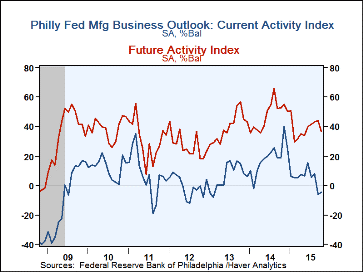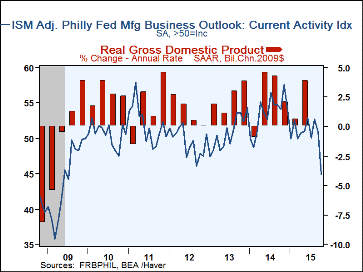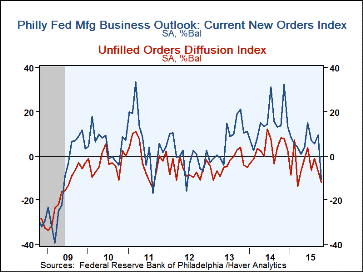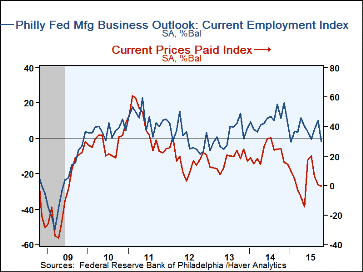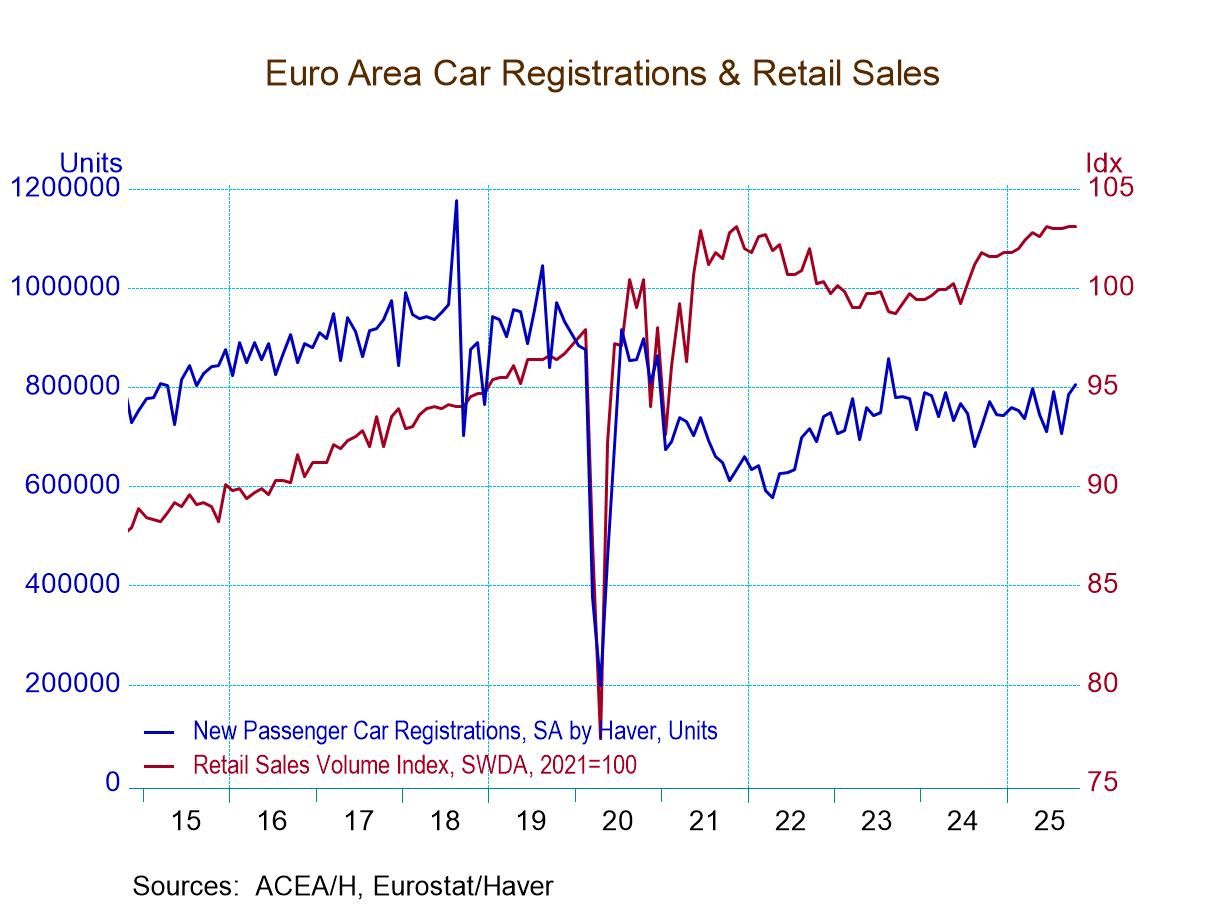 Global| Oct 15 2015
Global| Oct 15 2015Philadelphia Fed Business Conditions Remains Below Break-Even
by:Tom Moeller
|in:Economy in Brief
Summary
The Philadelphia Federal Reserve Bank reported that its General Factory Sector Business Conditions Index for October remained negative for the second straight month. At -4.5, the latest figure was barely above September's -6.0 and [...]
The Philadelphia Federal Reserve Bank reported that its General Factory Sector Business Conditions Index for October remained negative for the second straight month. At -4.5, the latest figure was barely above September's -6.0 and both were the first negative readings since early 2014. Expectations were for -2.0 in the Action Economics Forecast Survey.
The seasonally adjusted figure constructed by Haver Analytics declined to 44.7, the lowest figure since mid-2012. It is comparable to the ISM Composite index. During the last ten years, there has been a 71% correlation between the adjusted Philadelphia Fed index and real GDP growth.
The components of the overall index were uniformly negative this month and each fell versus September. Shipments and new orders showed notable m/m deterioration. The employment measure was negative for the first time in nine months. During the last ten years, there has been an 81% correlation between the jobs index and the m/m change in manufacturing payrolls.
On the pricing front, the prices paid index eased into negative territory to its lowest reading since May. Nineteen percent of respondents paid higher prices and 19% paid less, up from 7% just two months ago. The prices received measure improved to its highest level since June.
The future business activity index fell sharply to its lowest level since May. The decline reflected deterioration in most every series.
The survey panel consists of 150 manufacturing companies in Federal Reserve District III (consisting of southeastern PA, southern NJ and Delaware.) The diffusion indexes represent the percentage of respondents indicating an increase minus the percentage indicating a decrease in activity. The ISM adjusted figure, calculated by Haver Analytics, is the average of five diffusion indexes, new orders, production, employment, supplier deliveries and inventories with equal weights (20% each). Each diffusion index is the sum of the percent responding "higher" and one-half of the percent responding "same."
The figures from the Philadelphia Federal Reserve can be found in Haver's SURVEYS database. The Action Economics figure is available in AS1REPNA.
| Philadelphia Fed (%, SA) | Oct | Sep | Aug | Oct'14 | 2014 | 2013 | 2012 |
|---|---|---|---|---|---|---|---|
| ISM-Adjusted General Business Conditions | 44.7 | 51.0 | 52.6 | 54.6 | 53.7 | 50.0 | 47.8 |
| General Factory Sector Business Conditions | -4.5 | -6.0 | 8.3 | 19.0 | 18.6 | 6.4 | -0.2 |
| New Orders | -10.6 | 9.4 | 5.8 | 13.8 | 15.0 | 7.2 | -0.1 |
| Shipments | -6.1 | 14.8 | 16.7 | 20.0 | 16.4 | 7.1 | -1.3 |
| Unfilled Orders | -11.7 | -6.6 | -1.0 | 8.4 | 3.3 | -3.8 | -6.5 |
| Delivery Time | -1.2 | 0.5 | -0.4 | 2.6 | 0.7 | -4.0 | -9.1 |
| Inventories | -17.4 | -2.7 | 0.2 | 9.2 | 1.8 | -3.4 | -6.0 |
| Number of Employees | -1.7 | 10.2 | 5.3 | 11.2 | 10.6 | 1.5 | 0.1 |
| Prices Paid | -0.1 | 0.5 | 6.2 | 24.9 | 21.7 | 16.6 | 17.7 |
Tom Moeller
AuthorMore in Author Profile »Prior to joining Haver Analytics in 2000, Mr. Moeller worked as the Economist at Chancellor Capital Management from 1985 to 1999. There, he developed comprehensive economic forecasts and interpreted economic data for equity and fixed income portfolio managers. Also at Chancellor, Mr. Moeller worked as an equity analyst and was responsible for researching and rating companies in the economically sensitive automobile and housing industries for investment in Chancellor’s equity portfolio. Prior to joining Chancellor, Mr. Moeller was an Economist at Citibank from 1979 to 1984. He also analyzed pricing behavior in the metals industry for the Council on Wage and Price Stability in Washington, D.C. In 1999, Mr. Moeller received the award for most accurate forecast from the Forecasters' Club of New York. From 1990 to 1992 he was President of the New York Association for Business Economists. Mr. Moeller earned an M.B.A. in Finance from Fordham University, where he graduated in 1987. He holds a Bachelor of Arts in Economics from George Washington University.


